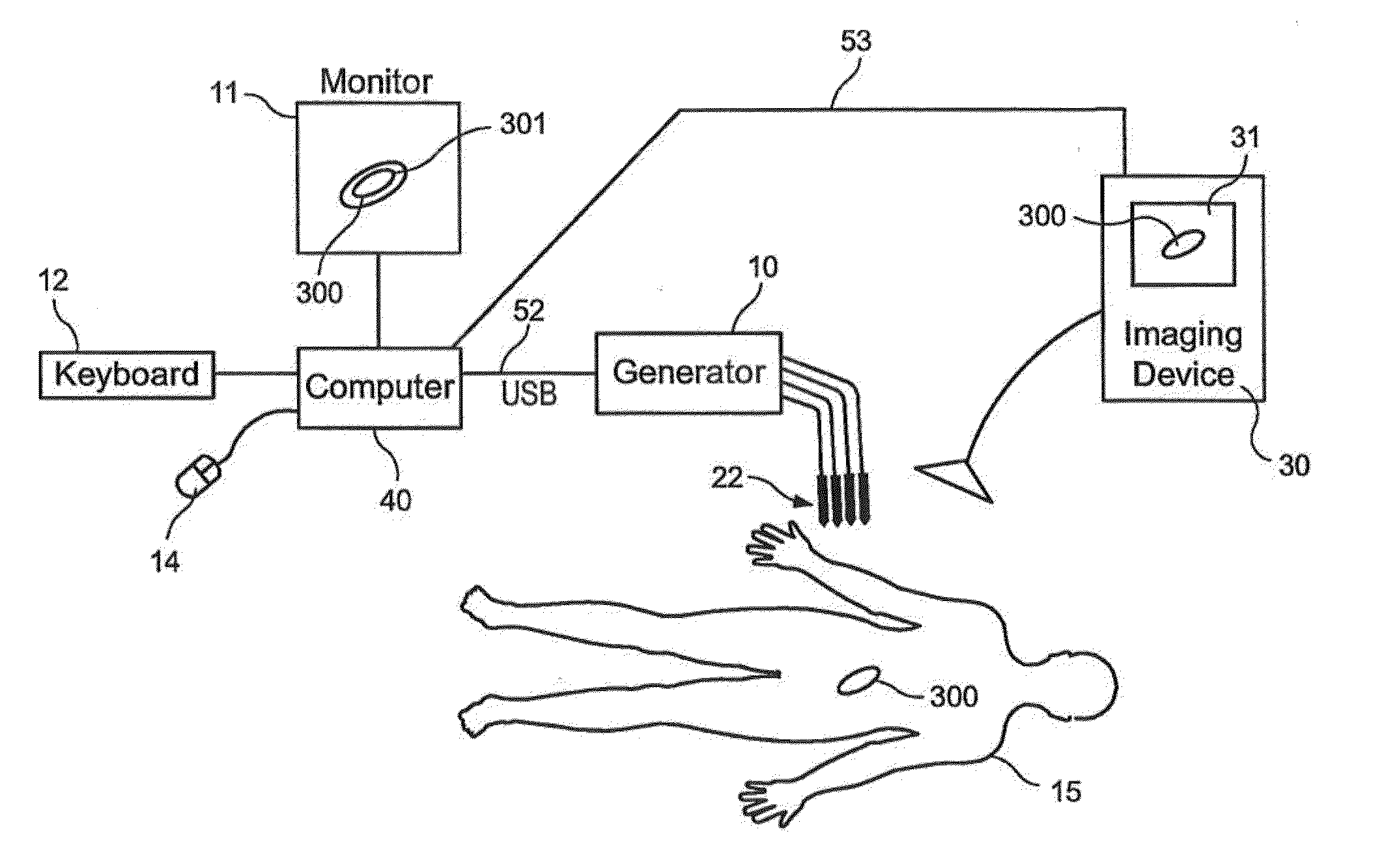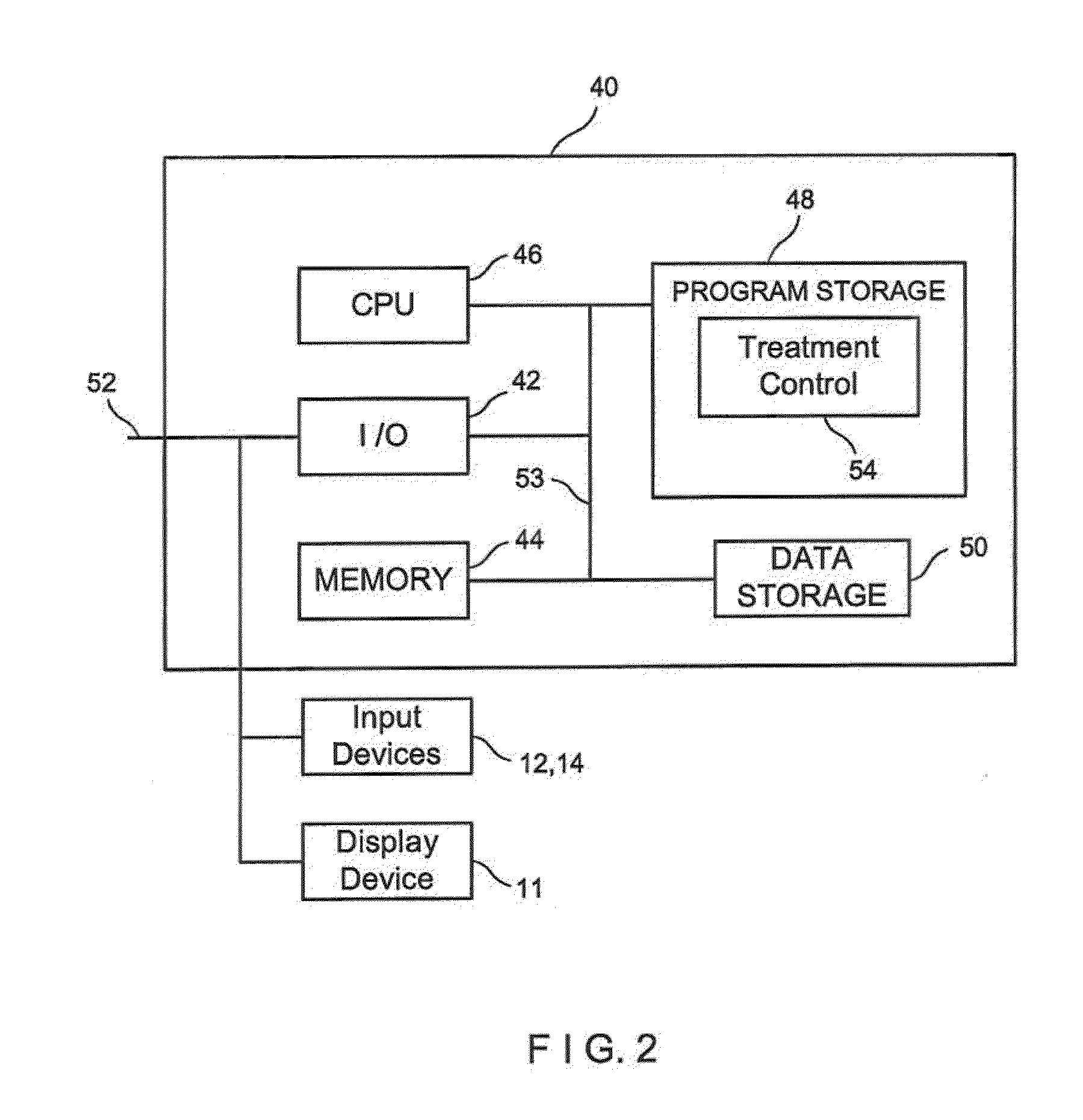Methods of Sterilization and Treating Infection Using Irreversible Electroporation
a technology of electroporation and sterilization, applied in the field of sterilization and infection treatment using irreversible electroporation, can solve the problems of death, medical devices can become infected, and long-term implants are particularly susceptible to infection
- Summary
- Abstract
- Description
- Claims
- Application Information
AI Technical Summary
Benefits of technology
Problems solved by technology
Method used
Image
Examples
example 1
[0117]If V=2495 Volts; a=0.7 cm; and A=650 V / cm;
[0118]Then b2=1.376377
[0119]and then a cassini curve can be plotted by using eq. (5) above by solving for r, for each degree of theta from 0 degrees to 360 degrees.
[0120]A portion of the solutions for eq. (5) are shown in Table 1 below:
[0121]where M=a2 cos(2*theta); and L=sqrt(b4−a4 sin2(2*theta))
TABLE 1Thetar =r =r =r =(degrees)sqrt(M + L)−sqrt(M + L)sqrt(M − L)−sqrt(M − L)01.366154−1.366150011.366006−1.366010021.365562−1.365560031.364822−1.364820041.363788−1.363790051.362461−1.362460061.360843−1.360840071.358936−1.358940081.356743−1.356740091.354267−1.3542700101.351512−1.3515100111.348481−1.3484800121.34518−1.3451800131.341611−1.3416100141.337782−1.3377800151.333697−1.333700
[0122]The above eq. (6) was developed according to the following analysis.
[0123]The curve from the cassini oval equation was calibrated as best as possible to the 650 V / cm contour line using two 1-mm diameter electrodes with an electrode spacing between 0.5-5 cm a...
example 2
[0147](x1, y1)=(−0.005 m, 0 m)
[0148](x2, y2)=(0.001 m, 0.003 m)
[0149]Vo=1000V
[0150]a=0.0010 m
[0151]d=0.006708 m
[0152]Using eqs. (10-13) above, the E-field values are determined for x, y coordinates on the grid, as shown in the spreadsheet at FIG. 16.
[0153]This method can also be used to determine the E-field values for devices having two plate electrodes or two concentric cylinders.
The Third Method
[0154]As an alternate method of estimating the treatment zone in real time, a predetermined set of values that define the outer boundary of a plurality of predetermined treatment zones (determined by FEA, one of the above two methods or the like) can be stored in memory as a data table and interpolation can be used to generate an actual treatment zone for a particular treatment area (e.g., tumor area).
[0155]Interpolation is commonly used to determine values that are between values in a look up table. For example if a value half way between 5 and 10 in the first row of the lookup table (see...
example 3
[0175]A device having 3 probes is used to treat a target tissue where:
[0176]a=2.0 cm; b=1.0 cm; and φ=0 degrees
[0177]Using Table 2.1, θ1=90°, θ2=210°, and θ3=330°
[0178]Using Table 2.2, ε3=0.70
[0179]Therefore, when using the “Autoset Probes” feature, and eqs. (14) and (15) above, the (x,y) locations on the grid for each probe are calculated as follows:
Probe #1
[0180]
x1=εj*a*cos(θi+φ)=0.70*2.0 cm*cos(90 degrees)=0
y1=εj*b*sin(θi+φ)=0.70*1.0 cm*sin(90 degrees)=0.70 cm
Probe #2
[0181]
x2=εj*a*cos(θi+φ)=0.70*2.0 cm*cos(210 degrees)=−1.21 cm
y2=εj*b*sin(θi+φ)=0.70*1.0 cm*sin(210 degrees)=−0.35 cm
Probe #3
[0182]
x3=εj*a*cos(θi+φ)=0.70*2.0 cm*cos(330 degrees)=1.21 cm
y3=εj*b*sin(θi+φ)=0.70*1.0 cm*sin(330 degrees)=−0.35 cm
[0183]Using Table 2.3, the firing sequence and respective polarity of the three probes will proceed as follows:
[0184](3 treatment pairs)[0185](+) Probe #1, (−) Probe #2[0186](+) Probe #2, (−) Probe #3[0187](+) Probe #3, (−) Probe #1
[0188]In another embodiment, the automatic probe pl...
PUM
 Login to View More
Login to View More Abstract
Description
Claims
Application Information
 Login to View More
Login to View More - R&D
- Intellectual Property
- Life Sciences
- Materials
- Tech Scout
- Unparalleled Data Quality
- Higher Quality Content
- 60% Fewer Hallucinations
Browse by: Latest US Patents, China's latest patents, Technical Efficacy Thesaurus, Application Domain, Technology Topic, Popular Technical Reports.
© 2025 PatSnap. All rights reserved.Legal|Privacy policy|Modern Slavery Act Transparency Statement|Sitemap|About US| Contact US: help@patsnap.com



